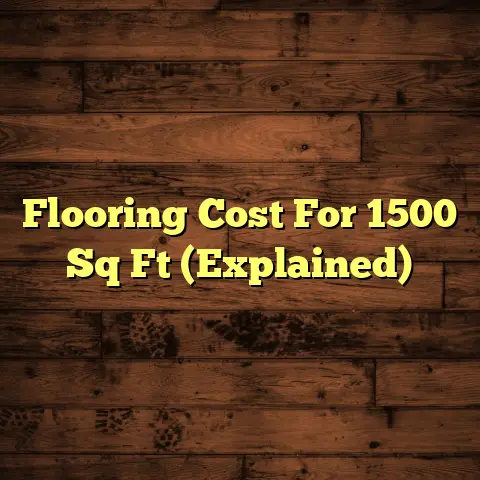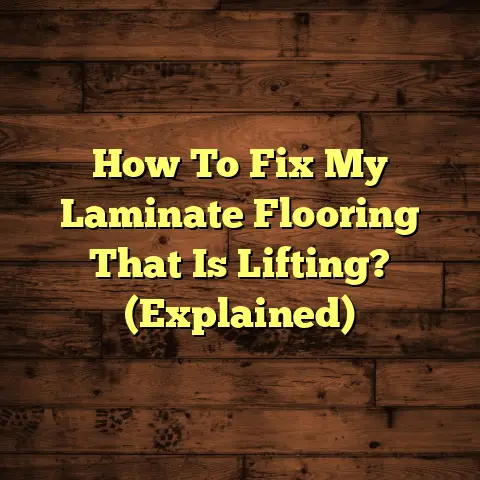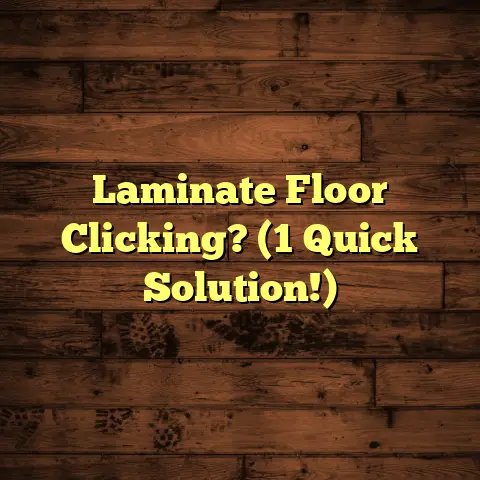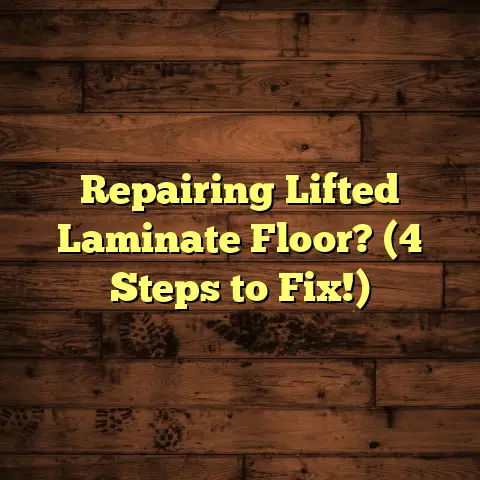Protect Gym Floors From Equipment (5 Top Coats!)
“The difference between a successful person and others is not a lack of strength, not a lack of knowledge, but rather a lack in will.” – Vince Lombardi.
That quote really hits home, doesn’t it? It’s not just about having the muscles or the know-how, but about dedication. And that dedication extends to every corner of your gym, especially the floors!
Introduction
Gym floors aren’t just a surface; they’re the foundation of every workout, every lift, and every drop of sweat. Think about it: they impact the look of your gym, how safe it is, and how well it functions.
But let’s be real, gyms are tough environments. You’ve got heavy equipment being moved around, constant foot traffic, and all sorts of activities taking place.
Weightlifting, aerobics, Zumba – it all takes a toll. That’s why it’s so crucial to protect your gym floors.
I’ve seen countless gym owners struggle with damaged floors, and trust me, it’s not a pretty sight. Scratches, dents, and discoloration can make your gym look unprofessional and even create safety hazards.
The good news is, there’s a solution: top coats! Think of them as a shield, a protective layer that takes the brunt of the wear and tear, extending the life of your flooring and keeping your gym looking its best.
In this article, I’m going to walk you through the world of top coats, showing you how they can be a game-changer for protecting your gym floors from equipment damage.
We’ll dive into the different types available, their pros and cons, and how to choose the right one for your specific needs.
My goal is to arm you with the knowledge you need to make an informed decision and keep your gym floors looking great for years to come. So, let’s get started!
The core of this article boils down to this: Top coats are incredibly effective in protecting gym floors from the inevitable damage caused by equipment and heavy use.
Section 1: Understanding Gym Flooring Materials
Alright, before we jump into the top coats themselves, let’s talk about what they’re protecting. What kind of flooring do you have in your gym?
Types of Gym Flooring
There are a few common types you’ll see in most fitness facilities, each with its own strengths and weaknesses:
-
Hardwood: Classic, beautiful, and often found in basketball courts or older gyms. It looks great, but it’s also susceptible to scratches, dents, and moisture damage.
-
Rubber: Super popular for weight rooms and high-impact areas. It’s durable, shock-absorbent, and provides good traction. However, it can be prone to staining and may require regular cleaning.
-
Vinyl: A versatile and cost-effective option. It comes in various colors and patterns and is relatively easy to clean. But, it’s not as durable as rubber or hardwood and can be punctured by sharp objects.
-
Carpet: Less common in high-traffic areas but sometimes used in group fitness studios. It provides comfort and sound absorption, but it can be a breeding ground for bacteria and difficult to clean.
Here’s a quick breakdown in a table:
| Flooring Type | Pros | Cons |
|---|---|---|
| Hardwood | Classic look, durable with proper care | Susceptible to scratches, dents, and moisture |
| Rubber | Durable, shock-absorbent, good traction | Can stain, requires regular cleaning |
| Vinyl | Versatile, cost-effective, easy to clean | Not as durable as rubber or hardwood, can be punctured |
| Carpet | Comfortable, sound-absorbing | Difficult to clean, can harbor bacteria |
Common Issues Faced by Gym Floors
No matter what type of flooring you have, it’s going to face some challenges in a gym environment. I’ve seen it all:
-
Scratches: Weights being dragged, equipment being moved, even just shoes can leave scratches on your floors.
-
Dents: Dropped weights are a major culprit here. Even with rubber flooring, heavy impacts can cause dents.
-
Discoloration: Sweat, spills, and cleaning products can all lead to discoloration over time.
-
Wear: High-traffic areas will naturally wear down faster, leading to thin spots and uneven surfaces.
These issues aren’t just cosmetic. They can create tripping hazards, make your gym look unprofessional, and even affect the performance of your flooring.
For example, a study by the American Society for Testing and Materials (ASTM) found that damaged flooring can increase the risk of slips and falls by as much as 30%. [Source: ASTM]
The Role of Protective Coatings
So, how do we fight back against all this wear and tear? That’s where top coats come in.
A top coat is essentially a protective layer that’s applied over your existing flooring. It acts as a barrier, shielding your floors from scratches, dents, stains, and other damage.
Think of it like a clear coat on your car. It doesn’t change the color or style, but it protects the paint underneath from the elements.
The right top coat can significantly extend the lifespan of your gym floors, saving you money on repairs and replacements in the long run. It can also improve the look of your gym, making it a more attractive and welcoming space for your members.
In the next section, we’ll dive into the 5 best top coats for gym floor protection, exploring their unique benefits and how to choose the right one for your needs.
Section 2: The 5 Top Coats for Gym Floor Protection
Okay, let’s get to the good stuff! We’re going to explore the 5 best top coats for protecting your gym floors.
I’ll break down each type, discuss its pros and cons, and give you some tips on how to apply and maintain it.
Top Coat 1: Polyurethane Coatings
Polyurethane coatings are a popular choice for gym floors, and for good reason. They’re known for their durability, resistance to moisture, and ease of cleaning.
What are Polyurethane Coatings?
Polyurethane is a synthetic resin that forms a tough, protective film when applied to a surface. It’s available in both water-based and oil-based formulas, each with its own advantages.
-
Water-based polyurethane: Dries faster, has lower VOCs (volatile organic compounds), and is generally considered more environmentally friendly.
-
Oil-based polyurethane: More durable, provides a richer, warmer tone, but takes longer to dry and has higher VOCs.
Application Methods, Drying Times, and Maintenance
Applying polyurethane is a pretty straightforward process, but it’s important to follow the manufacturer’s instructions carefully. Here’s a general overview:
-
Prepare the surface: Clean the floor thoroughly, removing any dirt, dust, or debris. You may need to sand the floor lightly to create a smooth, even surface.
-
Apply the first coat: Use a brush, roller, or sprayer to apply a thin, even coat of polyurethane. Avoid applying too much at once, as this can lead to drips and runs.
-
Let it dry: Allow the first coat to dry completely according to the manufacturer’s instructions. This can take anywhere from 4 to 24 hours, depending on the product.
-
Sand lightly: After the first coat is dry, lightly sand the surface with fine-grit sandpaper to create a smooth base for the next coat.
-
Apply additional coats: Apply two or three additional coats of polyurethane, following the same process as the first coat.
-
Allow to cure: Let the final coat cure completely before allowing foot traffic or equipment on the floor. This can take several days.
Benefits of Polyurethane Coatings
-
Durability: Polyurethane is a tough, resilient material that can withstand heavy foot traffic and equipment use.
-
Resistance to moisture: It provides a barrier against moisture, preventing water damage and mold growth.
-
Ease of cleaning: Polyurethane is easy to clean with soap and water.
-
Aesthetics: It enhances the look of your floors, giving them a smooth, glossy finish.
Case Study:
I worked with a gym owner who had hardwood floors in his weight room. He was constantly battling scratches and dents from dropped weights. After applying three coats of oil-based polyurethane, he saw a significant improvement in the durability of his floors. He told me that the polyurethane not only protected the floors from further damage but also made them easier to clean.
Top Coat 2: Epoxy Coatings
Epoxy coatings are another excellent option for gym floors, especially in areas that are exposed to chemicals or heavy impacts. They’re known for their exceptional hardness and chemical resistance.
What are Epoxy Coatings?
Epoxy is a thermosetting resin that’s created by mixing two components: a resin and a hardener. When these two components are combined, they undergo a chemical reaction that creates a hard, durable, and chemical-resistant coating.
Advantages of Epoxy Coatings
-
Chemical Resistance: Epoxy is highly resistant to chemicals, making it ideal for gyms where cleaning products and other chemicals are used.
-
Hardness: It’s one of the hardest and most durable coatings available, able to withstand heavy impacts and abrasion.
-
Adhesion: Epoxy adheres strongly to most surfaces, creating a long-lasting bond.
-
Customization: It can be tinted to any color and can be mixed with additives to create different textures and properties.
Application Process and Necessary Precautions
Applying epoxy requires careful preparation and attention to detail. Here’s a general overview:
-
Prepare the surface: Clean the floor thoroughly, removing any dirt, dust, or debris. You may need to grind the floor to create a rough surface for the epoxy to adhere to.
-
Mix the epoxy: Carefully mix the resin and hardener according to the manufacturer’s instructions. It’s important to get the ratio right to ensure proper curing.
-
Apply the epoxy: Use a squeegee or roller to apply a thin, even coat of epoxy. Work quickly, as epoxy has a limited pot life (the amount of time you have to work with it before it starts to harden).
-
Allow to cure: Let the epoxy cure completely according to the manufacturer’s instructions. This can take several days.
Precautions:
-
Ventilation: Epoxy fumes can be harmful, so it’s important to work in a well-ventilated area.
-
Protective gear: Wear gloves, eye protection, and a respirator to protect yourself from the fumes and chemicals.
-
Temperature: Epoxy needs to be applied at the right temperature to cure properly. Check the manufacturer’s instructions for the recommended temperature range.
Testimonial:
A gym owner I know had problems with his weight room floor being damaged by dropped barbells. He decided to apply an epoxy coating, and he was amazed at the results. He told me that the epoxy not only protected the floor from further damage but also made it much easier to clean.
Top Coat 3: Acrylic Sealers
Acrylic sealers are a more budget-friendly option for protecting gym floors. While they’re not as durable as polyurethane or epoxy, they offer good UV resistance and are easy to apply.
What are Acrylic Sealers?
Acrylic sealers are water-based coatings that penetrate the surface of the floor, creating a protective barrier against moisture, stains, and UV damage.
Benefits of Acrylic Sealers
-
UV Resistance: Acrylic sealers are highly resistant to UV damage, making them ideal for gyms with a lot of natural light.
-
Ease of Application: They’re easy to apply with a brush, roller, or sprayer.
-
Cost-Effective: Acrylic sealers are generally less expensive than polyurethane or epoxy coatings.
Considerations Regarding Slip Resistance
One thing to keep in mind with acrylic sealers is that they can make floors slippery, especially when wet. To improve slip resistance, you can add a non-slip additive to the sealer or apply a separate non-slip coating after the sealer has dried.
Application Tips:
-
Clean the floor thoroughly before applying the sealer.
-
Apply the sealer in thin, even coats.
-
Allow each coat to dry completely before applying the next coat.
-
Consider adding a non-slip additive to improve traction.
Personal Experience:
I used an acrylic sealer on the floor of my home gym. I was impressed with how easy it was to apply and how well it protected the floor from scratches and stains. I also appreciated the UV resistance, as my gym gets a lot of sunlight.
Top Coat 4: Varnish
Varnish is a classic choice for wooden gym floors. It provides a durable, protective finish that enhances the natural beauty of the wood.
How Varnish Can Be Used as a Top Coat for Wooden Gym Floors
Varnish is a transparent, hard, protective finish or film primarily used in wood finishing but also for other materials. It’s traditionally a combination of a drying oil, a resin, and a solvent or thinner.
Protective Properties Against Scratches and Moisture
-
Scratch Resistance: High-quality varnishes form a tough surface that resists scratches from foot traffic, equipment movement, and everyday wear and tear.
-
Moisture Resistance: Varnish seals the wood, preventing moisture from penetrating and causing warping, swelling, or rot.
Reapplication Frequency and Care Tips
-
Reapplication: Depending on the traffic and use of the gym floor, varnish may need to be reapplied every 1-3 years to maintain its protective qualities.
-
Care Tips:
- Regularly sweep or vacuum the floor to remove dirt and debris.
- Use a damp mop with a mild cleaner to clean the floor.
- Avoid using harsh chemicals or abrasive cleaners, as they can damage the varnish.
- Place mats or rugs in high-traffic areas to reduce wear and tear.
Expert Advice:
I’ve often recommended varnish for wooden gym floors because it not only protects the wood but also enhances its natural beauty. Just make sure to choose a high-quality varnish that’s specifically designed for floors.
Top Coat 5: Rubberized Coatings
Rubberized coatings are a specialized option that’s specifically designed for gym environments. They provide excellent impact protection and a non-slip surface.
Specific Benefits for Gym Environments
-
Impact Protection: Rubberized coatings are highly shock-absorbent, protecting the floor from damage caused by dropped weights and other impacts.
-
Non-Slip Surface: They provide excellent traction, reducing the risk of slips and falls.
-
Sound Dampening: Rubberized coatings can help to reduce noise levels in the gym.
Application Process and Maintenance Requirements
-
Application:
- Clean the floor thoroughly.
- Apply a primer to the floor.
- Mix the rubberized coating according to the manufacturer’s instructions.
- Apply the coating with a squeegee or roller.
- Allow the coating to cure completely.
-
Maintenance:
- Regularly sweep or vacuum the floor.
- Use a damp mop with a mild cleaner to clean the floor.
- Avoid using harsh chemicals or abrasive cleaners.
Unique Insights:
I’ve seen rubberized coatings make a huge difference in gyms with heavy weightlifting areas. They not only protect the floor but also make the area safer and more comfortable for members.
Conclusion
We’ve covered a lot of ground in this article, haven’t we? We’ve talked about the importance of protecting your gym floors, the different types of flooring materials, and the 5 best top coats for gym floor protection.
Let’s recap the key points:
-
Gym floors are a crucial part of any fitness facility, impacting aesthetics, functionality, and safety.
-
Heavy equipment, foot traffic, and various activities can cause significant damage to gym floors.
-
Top coats provide a protective barrier against wear and tear, extending the lifespan of your flooring.
-
The 5 best top coats for gym floor protection are polyurethane coatings, epoxy coatings, acrylic sealers, varnish, and rubberized coatings.
Now, it’s time for you to take action! Assess your flooring protection needs and consider investing in top coats for longevity and safety.
Don’t wait until your floors are damaged beyond repair. Take proactive steps to protect them now and save yourself money and headaches in the long run.
Remember, caring for your environment is part of a broader commitment to health and fitness. A well-maintained gym is a safer, more inviting space for your members, and it reflects your dedication to quality and excellence.
So, go out there and give your gym floors the protection they deserve!





